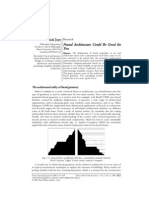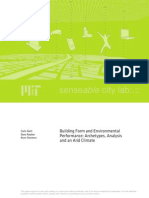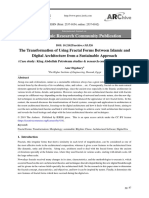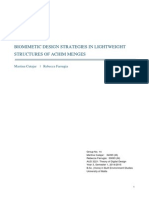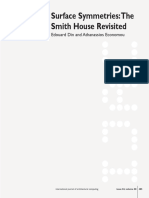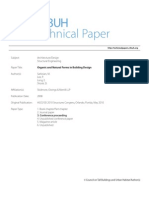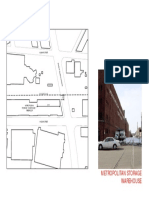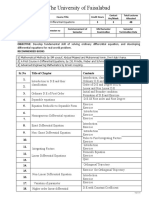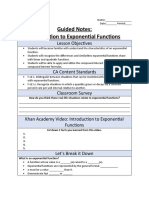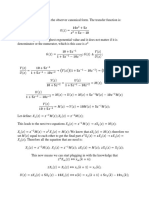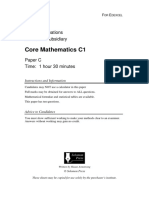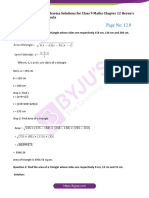Kjga02 PDF
Kjga02 PDF
Uploaded by
Dipu GeorgeCopyright:
Available Formats
Kjga02 PDF
Kjga02 PDF
Uploaded by
Dipu GeorgeOriginal Title
Copyright
Available Formats
Share this document
Did you find this document useful?
Is this content inappropriate?
Copyright:
Available Formats
Kjga02 PDF
Kjga02 PDF
Uploaded by
Dipu GeorgeCopyright:
Available Formats
Architectural Forms by Abstracting Nature
Prof. Kamon Jirapong, PhD.
Faculty of Architecture, Sripatum University, Bangkok, Thailand.
e-mail: jirapong@spu.ac.th
Prof. Robert J. Krawczyk
College of Architecture, Illinois Institute of Technology, Chicago, IL, USA
Abstract
The structures in nature are great lessons for human study. Having been in development for several
billion years, only the most successful structural forms have survived. The resourcefulness of material
use, the underlying structural systems and the profound capacity to respond to a variety of climatic
and environmental forces make natural form tremendous exemplars to human architectures. The
wholeness of natural form indicates that the form and forces are always in some sense of equilibrium.
In most of natural forms, the quality of equilibrium may be difficult to recognize. However, seashells
are one of the natural forms whose functions are simple enough to be approximated by a simple
mathematical relationship. The focus of this study was to understand the seashell form as applicable
to human architectures. Digital methods are the language to analyze, create, and simulate seashell
forms, as well as, suggest a variety of possible architectural forms.
1. The Study of Natural Forms
The study of seashells has a long history, starting with Henry Moseley in 1838 [1] and followed by
many researchers such as Thompson [2], Raup [3, 4], Cortie [5], and Dawkins [6]. These
researchers have outlined in a number of mathematical relationships that control the overall geometry
of shells. Our interest centers on an investigation of natural forms as a starting point to generate
architectural forms.
As documented by prior researchers, the seashell geometry can be expressed by four basic
parameters. Figure 1 indicates these parameters that influence the shell forms.
Generative Art 2002
Figure 1. The four parameters.
As shown in Figure 1a, A is the shape of the aperture or the shape of shell section, B is the distance
from the coiling axis to the center of the shell section, C is the section radius, and D is the vertical
distance between sections. To understand the mathematical relationship of these four parameters,
Figure 1b illustrates the measuring concept of one coiling shell of the gastropods class and Figure 2
illustrates its digital geometry reconstruction.
Figure 2. The wire frame and mesh model of selected seashell.
Each seashell can be reconstructed in a digital form with variations of the mathematical relationships
among the four parameters. The result of a specific mathematical combination reflects the shell form
for a specific seashell specie. In this study, the concept of creating architectural form originating from
seashell geometry can be accomplished by applying these parameters to an architectural form
interpretive exploring process.
Generative Art 2002
Using mathematics as a tool of investigation in both the natural and architectural forms gives us an
advantage of exploring multiple forms easily and allows us to implement new parameters into the
mathematical framework. Architecture, which exists in a dramatically different environment from the
seashell, has other parameters to be integrated during the architectural design process concerning its
form. These parameters are designed to accommodate the practical requirements of architectural
forms.
2. Abstracting Nature
The abstracting process combines three major components that influence the final result of an
architectural form. These components are the seashell geometry properties, seashell structural
properties and architectural properties.
2.1 Seashell Geometry Properties
There are four known parameters in the study of seashell geometry; path, section, growth and
vertical displacement. Each parameter is represented by a specific mathematical curve in which it can
be replaced with series of different mathematical curves to develop an architectural form. In the
seashell form these mathematical curves are limited to those that appeared in the actual geometry of
shell such as logarithmic spiral, circle and ellipse. In the architectural form the limitations are less,
however, only mathematically defined curves are chosen in this investigation according to the fact that
seashell form always exhibits a curvature. For a clearer understanding in replacing seashell
parameters with other mathematical functions, the mathematical curves are divided in to two simple
groups based on their mathematical properties; closed curves and open curves. Figure 3 illustrates
the sample of closed and open curves and diagram indicates the use of each group.
2.2 Seashell Structural Properties
The actual shell geometry responses to any load outside by redirecting forces within a very thin
section of shell structure along its natural multiple curvatures. Finally those forces are transferred to
the supported area such as ground, rock or sand depending upon how the seashell positions itself in
the environment. By acknowledging this structural phenomenon and understanding its weakness
against tension forces, the compressive shell form suggests the possible structure of the architectural
form beyond the existing forms of man-made shell structure. Its structural properties applied to
architectural interpretations are included the shape of section, the overlapping section, and the
support condition.
Generative Art 2002
2.3 Architectural Properties
In architecture, there are some basic design criteria that architects and engineers have to take into
consideration when developing building forms. In this investigation those criteria are treated as
architectural parameters. These parameters emerge from architectural design principles that make
architectural forms inhabitable. Without a specific requirement of an actual site and functions, the
architectural parameters for this study can be set as ground condition, orientation, human scale and
enclosure.
As architectural forms are developed the interpretation of these three major components yield the
resultant of architectural form that contains the qualities of the seashell.
The architectural form generating concept adopts the four parameters from the seashell geometry and
implements additional conditions based on architectural and structural properties into one
mathematical framework. This mathematical framework then generates the result of the architectural
form. Figure 3 illustrates the diagram of related parameters in various combinations that enable
architectural form to be generated.
Figure 3. Architectural form generating diagram and mathematical curves.
To illustrate the possibilities of architectural forms generated in this process, samples of conventional
and unconventional architectural forms are presented in Figure 4.
Generative Art 2002
Figure 4. Sample of generating forms .
3. Architectural Applications
The result of forms developed by this process can be applied for specific architectural functions.
Figures 5 exhibit the idea of how these forms can be used as architectural applications. Each form
displays a virtual quality of architecture and is ready to be developed further to a real architecture
with proper material and structural system selection.
Generative Art 2002
Figure 5. Sample of the architectural applications.
Generative Art 2002
4. Observation and Conclusion
This research concluded that the value of the study of nature is not only for its power of inspiration
and influence, but also for its abstract geometric properties. If the abstract properties can be
described by the mathematical relationship, they can then be developed into a built form. The
translation of abstracted nature in conjunction in concrete mathematical terms and by applying
prerequisite architectural considerations is the fundamental concept of this form development.
The value of this research is the process of developing mathematically definable models into an
architectural form. The process is flexible enough to be adjusted to a variety of parameters according
to the specific requirements of each architectural project. The results are a family of architectural
forms based on one simple mathematical comprehensive relationship.
5. References
[1] Moseley, H.: 1838, On the Geometrical Forms of Turbinated and Discoid Shells,
Philosophical Transactions of Royal Society of London
[2] Thompson, D’Arcy: 1992, On Growth and Form: The Complete Revised Edition, Dover
Publications, Inc., New York.
[3] Raup, D. M.: 1961, The Geometry of Coiling in Gastropods, Proceedings of the National
Academy of Sciences of the United States of America, Volume 47.
[4] Raup, D. M.: 1962, Computer as Aid in Describing Form in Gastropod Shells, Science,
July-September.
[5] Cortie, M. B.: 1989, Models for Mollusc Shell Shape, South African, Journal of Science.
[6] Dawkins, R.: 1997, Climbing Mount Improbable, W. W. Norton & Company.
Generative Art 2002
You might also like
- Geometric Shape GeneratorDocument23 pagesGeometric Shape GeneratorAhmedYahiaEnabNo ratings yet
- Fractal ArchitectureDocument10 pagesFractal ArchitecturecsisaNo ratings yet
- Math Poster RubricDocument3 pagesMath Poster Rubricapi-299503998No ratings yet
- RATTI RAYDAN STEEMERS. Building Form and Environmental PerformanceDocument12 pagesRATTI RAYDAN STEEMERS. Building Form and Environmental PerformancebsceciliaNo ratings yet
- Describing The Geometric Difference of Architectural Forms in Three Primary Shapes of Circle Triangle and SquareDocument22 pagesDescribing The Geometric Difference of Architectural Forms in Three Primary Shapes of Circle Triangle and SquareJ.C.VNo ratings yet
- Fractal Geometry and Architecture Design: Case Study Review: January 2012Document13 pagesFractal Geometry and Architecture Design: Case Study Review: January 2012Jennifer AngelNo ratings yet
- The Academic Research Community PublicationDocument12 pagesThe Academic Research Community PublicationIEREKPRESSNo ratings yet
- Designing Strategies For Topological Interlocking Assemblies in Architecture. Flat Vaults (2019)Document9 pagesDesigning Strategies For Topological Interlocking Assemblies in Architecture. Flat Vaults (2019)jlnederNo ratings yet
- 116799 Roudavski Towards Morphogenesis in Architecture 09Document31 pages116799 Roudavski Towards Morphogenesis in Architecture 09Ankit kumarNo ratings yet
- Paper Epoka2012Document9 pagesPaper Epoka2012sanafakieh2020No ratings yet
- Roudavski Towards Morphogenesis in Architecture 09Document30 pagesRoudavski Towards Morphogenesis in Architecture 09Jack Danai SurasaNo ratings yet
- Semiotics of Architectural Ornament - A Method of AnalysisDocument17 pagesSemiotics of Architectural Ornament - A Method of Analysiscristian.fl.bergerNo ratings yet
- Form-Finding, Force and Function: A Thin Shell Concrete Trolley Barn For Seattle's WaterfrontDocument34 pagesForm-Finding, Force and Function: A Thin Shell Concrete Trolley Barn For Seattle's WaterfrontMauricio FelipeNo ratings yet
- Extended Abstract - 69796 - Desgin and Applications of Ultra-Thin Free-Form Shell StructuresDocument12 pagesExtended Abstract - 69796 - Desgin and Applications of Ultra-Thin Free-Form Shell Structuresنصرالدين ادريسNo ratings yet
- Fractals in Architectural Design and CritiqueDocument18 pagesFractals in Architectural Design and CritiqueRaluca PopoviciNo ratings yet
- Design Challenges of Reciprocal Frame Structures in Architecture 2019Document16 pagesDesign Challenges of Reciprocal Frame Structures in Architecture 2019delaxoNo ratings yet
- Point Line PlaneDocument63 pagesPoint Line PlaneHeba EissaNo ratings yet
- Kravchenko 2019 IOP Conf. Ser. Mater. Sci. Eng. 698 022017Document6 pagesKravchenko 2019 IOP Conf. Ser. Mater. Sci. Eng. 698 022017Eduardo SilvaNo ratings yet
- Sacred Geometry: Analyzing Geometry in Indian Temple ArchitectureDocument12 pagesSacred Geometry: Analyzing Geometry in Indian Temple ArchitectureAshish Kumar JhaNo ratings yet
- A Proposal For The Use of Fractal Geometry Algorithmically in Tiling DesignDocument17 pagesA Proposal For The Use of Fractal Geometry Algorithmically in Tiling Designnada elzanatyNo ratings yet
- Pergerakan ArsitekturDocument7 pagesPergerakan Arsitekturrobi kamilNo ratings yet
- Fractal Geometry in Architecture PDFDocument12 pagesFractal Geometry in Architecture PDFSarthak MakkarNo ratings yet
- Group 14 - Biomimentic Design Strategies in Lightweight Structures of Achim Menges PDFDocument29 pagesGroup 14 - Biomimentic Design Strategies in Lightweight Structures of Achim Menges PDFtintintinaaNo ratings yet
- Tree-Inspired Dendriforms and Fractal-Like Branching Structures in Architecture: A Brief Historical OverviewDocument26 pagesTree-Inspired Dendriforms and Fractal-Like Branching Structures in Architecture: A Brief Historical OverviewmercosurNo ratings yet
- Bionic Architecture, Forms and Constructions: Review PaperDocument6 pagesBionic Architecture, Forms and Constructions: Review PaperAlb GabdoullinNo ratings yet
- Rossi2006 Article NaturalArchitectureAndConstruc PDFDocument11 pagesRossi2006 Article NaturalArchitectureAndConstruc PDFAarti ChandrasekharNo ratings yet
- An Evolutionary Architecture:: Adapted, Interactive, and Effectively Integrated DesignDocument6 pagesAn Evolutionary Architecture:: Adapted, Interactive, and Effectively Integrated DesignAntonio C. KeithNo ratings yet
- Computation and Construction of Vault Geometry PrototypesDocument6 pagesComputation and Construction of Vault Geometry PrototypesSofia GambettaNo ratings yet
- Study of The Control of Geometric Pattern Using Digital AlgorithmDocument14 pagesStudy of The Control of Geometric Pattern Using Digital Algorithmmimid beNo ratings yet
- Sphericity and Roundness Computation For ParticlesDocument13 pagesSphericity and Roundness Computation For Particlesdeena adleenaNo ratings yet
- Impactsof Symmetryin Architectureand UrbanismDocument21 pagesImpactsof Symmetryin Architectureand UrbanismΕυα κμNo ratings yet
- Generating Fractals Based On Spatial Organizations Ann Element Natural MethodDocument9 pagesGenerating Fractals Based On Spatial Organizations Ann Element Natural MethodEndless LoveNo ratings yet
- Form Exploration and GA Based OptimizatiDocument8 pagesForm Exploration and GA Based Optimizatijorge P.No ratings yet
- Surface Symmetries The Smith House Revis PDFDocument22 pagesSurface Symmetries The Smith House Revis PDFAlisson CabreraNo ratings yet
- Ijss Ori tsg1Document14 pagesIjss Ori tsg11032220018No ratings yet
- Fractal Fracture Mechanics Applied To Materials Engineering: December 2012Document41 pagesFractal Fracture Mechanics Applied To Materials Engineering: December 2012V.v. TaguisNo ratings yet
- Extremely Heavy and Incredibly LightDocument15 pagesExtremely Heavy and Incredibly LightMirco BeckerNo ratings yet
- A Fractal Approach For Optimization of Daylighting by Exploring The Window GeometryDocument12 pagesA Fractal Approach For Optimization of Daylighting by Exploring The Window Geometrynada elzanatyNo ratings yet
- Discrete Surfaces For Architectural Design: Helmut Pottmann, Sigrid Brell-Cokcan, and Johannes WallnerDocument22 pagesDiscrete Surfaces For Architectural Design: Helmut Pottmann, Sigrid Brell-Cokcan, and Johannes WallnermahboubehheidarianNo ratings yet
- Biomimicry As A Sustainable Solution in ArchitectuDocument13 pagesBiomimicry As A Sustainable Solution in ArchitectuShreeya SNo ratings yet
- Bio-Inspired Design Tool To Emerge Multifractal Forms: Bashar Swaid, Eleonora Bilotta, Pietro Pantano, Roberta LucenteDocument9 pagesBio-Inspired Design Tool To Emerge Multifractal Forms: Bashar Swaid, Eleonora Bilotta, Pietro Pantano, Roberta LucenteijasrjournalNo ratings yet
- 1 s2.0 S1364032117302150 MainDocument18 pages1 s2.0 S1364032117302150 MainLeslayVelezmoroNo ratings yet
- (Pseudo Coupled Method) B.breeveld - ReportDocument115 pages(Pseudo Coupled Method) B.breeveld - Reportcaner_kurtoglu-1100% (1)
- Jorn H KruhlDocument20 pagesJorn H KruhlSumanNo ratings yet
- Transforming Architectures Inspired by Origami: CommentaryDocument2 pagesTransforming Architectures Inspired by Origami: CommentaryMichael PoonNo ratings yet
- COMPDYN 2019 Fin 01052019Document13 pagesCOMPDYN 2019 Fin 01052019George MarkouNo ratings yet
- A Topologically Based Framework For 3-D Basin Modeling: Ulisses T. MelloDocument15 pagesA Topologically Based Framework For 3-D Basin Modeling: Ulisses T. MelloThomas AyeniNo ratings yet
- CHAPTER 1 - Introduction To Structural TheoryDocument11 pagesCHAPTER 1 - Introduction To Structural TheoryJoshua John JulioNo ratings yet
- 1.1. GENERAL: Chapter OneDocument69 pages1.1. GENERAL: Chapter OneAthira VkNo ratings yet
- (PAPER) Burland J.B. (2004) Interaction Between Structural and Geotechnical Engineers - JSD - Hong - Kong01 PDFDocument29 pages(PAPER) Burland J.B. (2004) Interaction Between Structural and Geotechnical Engineers - JSD - Hong - Kong01 PDFO SNo ratings yet
- Ctbuh Technical Paper: Organic and Natural Forms in Building DesignDocument13 pagesCtbuh Technical Paper: Organic and Natural Forms in Building DesignMarco SalvNo ratings yet
- 2515-Article Text PDF-6273-1-10-20130718Document14 pages2515-Article Text PDF-6273-1-10-20130718Tran LeNo ratings yet
- 2017 MI ClusteringDocument17 pages2017 MI ClusteringmakkusaNo ratings yet
- DT106-ARCHITECTURAL-DRAFTING-and-DESIGN-Module-2-Study-GuideDocument11 pagesDT106-ARCHITECTURAL-DRAFTING-and-DESIGN-Module-2-Study-Guidearcelonaangel17No ratings yet
- Estructuras Desplegables (LITA)Document8 pagesEstructuras Desplegables (LITA)kgoralskaNo ratings yet
- Leveraging Distortions: Explanation, Idealization, and Universality in ScienceFrom EverandLeveraging Distortions: Explanation, Idealization, and Universality in ScienceNo ratings yet
- Fractal Architecture: Organic Design Philosophy in Theory and PracticeFrom EverandFractal Architecture: Organic Design Philosophy in Theory and PracticeNo ratings yet
- Metal Stairs: 1.0 GeneralDocument7 pagesMetal Stairs: 1.0 GeneralDipu GeorgeNo ratings yet
- Brian Miller - Above The Fold - Understanding The Principles of Successful Web Site Design (2011, HOW)Document13 pagesBrian Miller - Above The Fold - Understanding The Principles of Successful Web Site Design (2011, HOW)Dipu GeorgeNo ratings yet
- A Competency-Directed Curriculum For Industrial Design EngineeringDocument6 pagesA Competency-Directed Curriculum For Industrial Design EngineeringDipu GeorgeNo ratings yet
- Media Lab Medical CenterDocument1 pageMedia Lab Medical CenterDipu GeorgeNo ratings yet
- Dan Hurley - Smarter - The New Science of Building Brain Power-Hudson Street Press (2013)Document11 pagesDan Hurley - Smarter - The New Science of Building Brain Power-Hudson Street Press (2013)Dipu GeorgeNo ratings yet
- Sailing Yacht DesignDocument4 pagesSailing Yacht DesignDipu GeorgeNo ratings yet
- Product DesignDocument14 pagesProduct DesignDipu GeorgeNo ratings yet
- 2e HoveringrelationDocument1 page2e HoveringrelationDipu GeorgeNo ratings yet
- TKM School of Architecture: Geology 101 Report 1Document1 pageTKM School of Architecture: Geology 101 Report 1Dipu GeorgeNo ratings yet
- Lesson Plan (Climatology s3)Document2 pagesLesson Plan (Climatology s3)Dipu George100% (2)
- Private Acts in Public Spaces: 4.104 Intentions in Architectural DesignDocument1 pagePrivate Acts in Public Spaces: 4.104 Intentions in Architectural DesignDipu GeorgeNo ratings yet
- Acoutics Answer KeyDocument2 pagesAcoutics Answer KeyDipu GeorgeNo ratings yet
- Week 1-Lecture NotesDocument12 pagesWeek 1-Lecture NotesDipu GeorgeNo ratings yet
- Addendum Reference Examples Below:: CEE 130 - Introduction To Architecture Studio Assignment: Concept ModelDocument4 pagesAddendum Reference Examples Below:: CEE 130 - Introduction To Architecture Studio Assignment: Concept ModelDipu GeorgeNo ratings yet
- Title of Curriculum/Program Lesson PlanDocument4 pagesTitle of Curriculum/Program Lesson PlanDipu GeorgeNo ratings yet
- TKM School of Architecture: SyllabusDocument4 pagesTKM School of Architecture: SyllabusDipu GeorgeNo ratings yet
- Lesson Plan (Climatology s3)Document2 pagesLesson Plan (Climatology s3)Dipu George100% (2)
- Dipu Build Mat PDFDocument55 pagesDipu Build Mat PDFDipu GeorgeNo ratings yet
- Differential EquationsDocument2 pagesDifferential EquationsHamzaNo ratings yet
- Key Components of OBE and AccreditationDocument61 pagesKey Components of OBE and Accreditationpvs-1983No ratings yet
- Real Analysis Lecture 4newDocument15 pagesReal Analysis Lecture 4newJohn Michael Ochea NatadNo ratings yet
- 2023 Released Items Math g6Document34 pages2023 Released Items Math g6sumeet610No ratings yet
- Grade 11 Second QuarterDocument2 pagesGrade 11 Second Quarterjesie rex regañon100% (1)
- 2ED Advanced Math William Guo ToC RefDocument11 pages2ED Advanced Math William Guo ToC Refstephen562001No ratings yet
- Notes - Number System - For StudentsDocument176 pagesNotes - Number System - For Studentsapi-261894355No ratings yet
- Edsc 304 Weebly Guided NotesDocument6 pagesEdsc 304 Weebly Guided Notesapi-500928296No ratings yet
- Regression in Open Office/ Libre Office: The Linear Regression EquationDocument2 pagesRegression in Open Office/ Libre Office: The Linear Regression Equationdebojit.dasNo ratings yet
- Quiz 1 EE 472 For UNLVDocument4 pagesQuiz 1 EE 472 For UNLVistraight1No ratings yet
- Solomon C QP - C1 Edexcel PDFDocument4 pagesSolomon C QP - C1 Edexcel PDFPakistan English AcademyNo ratings yet
- Mechanics and Materials: Chapter 6: BendingDocument37 pagesMechanics and Materials: Chapter 6: BendingMuhammad Mumtaz Ahmad100% (1)
- RD Sharma Solution Class 9 Maths Chapter 12 Herons FormulaDocument20 pagesRD Sharma Solution Class 9 Maths Chapter 12 Herons FormulaSaravanan MariNo ratings yet
- Sciencedirect: Categorical Principal Component Logistic Regression: A Case Study For Housing Loan ApprovalDocument7 pagesSciencedirect: Categorical Principal Component Logistic Regression: A Case Study For Housing Loan ApprovallaylaNo ratings yet
- Exsheet 1Document2 pagesExsheet 1mousa bagherpourjahromiNo ratings yet
- Tangent Plane: Exercise 2Document2 pagesTangent Plane: Exercise 2ნიკა ქურდაძეNo ratings yet
- Math 7Document4 pagesMath 7Xiv Nix100% (1)
- 6 PLC Program To Implement Binary To BCD ConverterDocument5 pages6 PLC Program To Implement Binary To BCD ConverterMaria GuerreroNo ratings yet
- Unit B2: Limit, Continuity and Differentiability: Detailed Content Time Ratio Notes On TeachingDocument3 pagesUnit B2: Limit, Continuity and Differentiability: Detailed Content Time Ratio Notes On TeachingdivithNo ratings yet
- Number Systems: ObjectivesDocument25 pagesNumber Systems: ObjectivesKhanh HungNo ratings yet
- DLL - Mathematics 5 - Q2 - W6Document5 pagesDLL - Mathematics 5 - Q2 - W6rodel acupiadoNo ratings yet
- Class 8 Chapter 2 Maths Important FormulasDocument3 pagesClass 8 Chapter 2 Maths Important Formulasdheerajchoudhary116No ratings yet
- Math 220A Practice Final Exam I Solutions - Fall 2002Document12 pagesMath 220A Practice Final Exam I Solutions - Fall 2002Claribel Paola Serna CelinNo ratings yet
- EST I Practice LinksDocument3 pagesEST I Practice LinksMohammed AbdallahNo ratings yet
- Calculus Optimization Problems SolutionsDocument3 pagesCalculus Optimization Problems SolutionsDonnabell PagaraNo ratings yet
- ScnotesDocument96 pagesScnotes2420570No ratings yet
- Set Theory Union and Intersection and Venn DiagramDocument21 pagesSet Theory Union and Intersection and Venn DiagramRita Soni100% (1)
- Tips To WriteDocument5 pagesTips To Writecool.meenuNo ratings yet
- Binomial Distribution WorksheetDocument39 pagesBinomial Distribution WorksheetSyed Ali ZafarNo ratings yet

